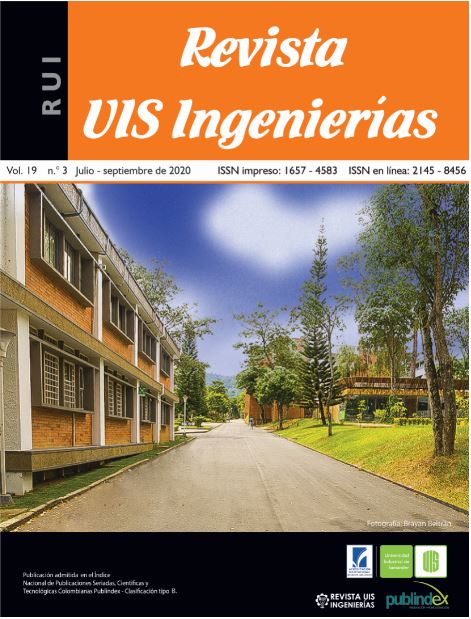CNC router kinematic calibration using a quasi-static error model and monocular photogrammetry
Published 2020-04-27
Keywords
- machine tools,
- calibration,
- simulation models,
- photogrammetry
How to Cite
Copyright (c) 2020 Revista UIS Ingenierías

This work is licensed under a Creative Commons Attribution-NoDerivatives 4.0 International License.
Abstract
Precision and accuracy, which are common requirements in manufacturing processes, are defined by the manufacturing context, both from the specifications of the process and from the manufacturing system itself. In this context, the kinematic calibration of electromechanical systems contributes to achieve manufacturing requirements. This paper presents a kinematic calibration method for a CNC router that operates in a context of ISO 2768-c linear dimensional tolerances. The calibration method is based on the estimation of the parameters of a kinematic model with a representation of dimensional variations (linear and angular) of the structure. The estimation of the parameters is based on machining errors measured by monocular photogrammetry of a geometric pattern that records a machining. The calibration was implemented on a CNC machine by adjusting the G code, thus meeting the manufacturing requirements demanded by the proposed context.
Downloads
References
[2] M. Wan, Y. Liu, W. Zhang, “A New Algorithm for the Identification of CNC Geometric Errors,” Procedia CIRP, vol. 56, pp. 293-298, 2016. doi: 10.1016/j.procir.2016.10.086
[3] S. Xiang y Y. Altintas, “Modeling and Compensation of Volumetric Errors for Five-axis Machine Tools,” International Journal of Machine Tools and Manufacture, vol. 101, pp. 65-78, 2016. doi: 10.1016/j.ijmachtools.2015.11.006
[4] Y. Qiao, Y. Chen, J. Yang, B. Chen, “A Five-axis Geometric Errors Calibration Model based on the Common Perpendicular Line (CPL) Transformation using the Product of Exponentials,” International Journal of Machine Tools and Manufacture, vol. 118-119, pp. 49-60, 2017. doi: 10.1016/j.ijmachtools.2017.04.003
[5] J. Yang, J. Mayer, Y. Altintas, “A Position Independent Geometric Errors Identification and Correction Method for Five-axis Serial Machines based on Screw Theory,” International Journal of Machine Tools and Manufacture, vol. 95, pp. 52-66, 2015. doi: 10.1016/j.ijmachtools.2015.04.011
[6] S. Ibaraki y W. Knapp, “Indirect Measurement of Volumetric Accuracy for Three-axis and Five-axis Machine Tools: A Review,” International Journal of Automation Technology, vol. 6, no. 2, pp. 110-124, 2012. doi: 10.3929/ethz-a-007593181
[7] J. Yang, H. Ding, “A New Position Independent Geometric Errors Identification Model of Five-axis Serial Machine Tools based on Differential Motion Matrices,” International Journal of Machine Tools and Manufacture, vol. 104, pp. 68-77, 2016. doi: 1016/j.ijmachtools.2016.02.001
[8] S. Xiang, H. Li, M. Deng y J. Yang, “Geometric Error Analysis and Compensation for Multi-axis Spiral Bevel Gears Milling Machine,” Mechanism and Machine Theory, vol. 121, pp. 59-74, 2018. doi: 10.1016/j.mechmachtheory.2017.10.014.
[9] A. Cifuentes, E. C. Nieto, “La rugosidad influenciada por factores geométricos en fresado de superficies,” Revista UIS Ingenierías, vol. 18, no. 2, pp. 121-130, 2019. doi: 10.18273/revuin.v18n2-2019011
[10] V. Kiridena, P. M. Ferreira, “Kinematic Modeling of Quasistatic Errors of Three-axis Machining Center,” International Journal of Machine Tools and Manufacture, vol. 34, no. 1, pp. 85-100, 1994. doi: 10.1016/0890-6955(94)90042-6
[11] V. Kiridena, P. M. Ferreira, “Parameter estimation and model verification of first order quasistatic error model for three-axis machining center,” International Journal pf Machine Tools and Manufacture, vol. 34, no. 1, pp. 101-125, 1994. doi: 10.1016/0890-6955(94)90043-4
[12] V. Kiridena, P. M. Ferreira, “Computational approaches to compensating quasistatic errors of three-axis machinig center,” International Journal of Machine Tools and Manufacture, vol. 34, no. 1, pp. 127-145, 1994. doi: 10.1016/0890-6955(94)90044-2
[13] H. Zuang, J. Yan, O. Masory, “Calibration of stewart platforms and other parallel manipulators by minimizing inverse kinematic residuals,” Journal of Fields Robotics, vol. 15, no. 7, pp. 395-405, 1998. doi: 10.1002/(SICI)1097-4563(199807)15:7<395::AID-ROB2>3.0.CO;2-H
[14] J. R. Ibañez, S. S. Marquez, E. T. Higuera, M. C. Salcedo, E. Y. Rodriguez, J. R. Mckinley, “Controlador CNC para modernización del proceso de fresado a bajo costo: caso con fresadora Supernova,” Revista UIS Ingenierías, vol. 18, no. 3, pp. 95-104, 2019. doi: 10.18273/revuin.v18n3-2019010
[15] D. J. Novoa, J. G. Bustamante, W. A. Chaparro, “Dispositivo de alineación de muestras para el difractómetro de rayos X con control de posición e interfaz de manipulación,” Respuestas, vol. 22, no. 1, pp. 84-95, 2017. doi: 10.22463/0122820X.856
[16] R. Tsai, “A versatil camera calibration technique for hign-accuracy 3d machine vision metrology using off-the-shelt tv cameras and lenses,” IEEE Journal on Robotics abd Automation, vol. 3, no.4, pp. 323-344, 1987.
[17] P. Corke, Robotics, Vision and Control (Second edition), Berlin: Springer, 2017.
[18] O. Masory, J. Wang, H. Zhuang, “On the accuracy of stewart platform ii. kinematic calibration an d compensation,” Robotics and Automation, Proceedings IEEE International Conference, pp. 725-731, 1993.
[19] M. P. Hermandez, Evaluación de Datos de Medición. Guía para la expresión de la incertidumbre de medida (primera edición), Madrid: Centro Español de Metrología, 2008.

